You'll find several clay materials excellent for efficient home temperature control. Adobe clay, bentonite clay, and kaolin clay offer natural regulation and humidity control. Terracotta's porous structure promotes air circulation and heat absorption. Earthen plaster moderates indoor humidity while providing insulation. Rammed earth and cob construction boast impressive thermal mass properties, absorbing heat during the day and releasing it at night. These sustainable options not only regulate temperature but also improve indoor air quality and energy efficiency. Exploring these clay materials further will reveal their unique benefits and applications for creating a comfortable, eco-friendly living space.
Adobe Clay
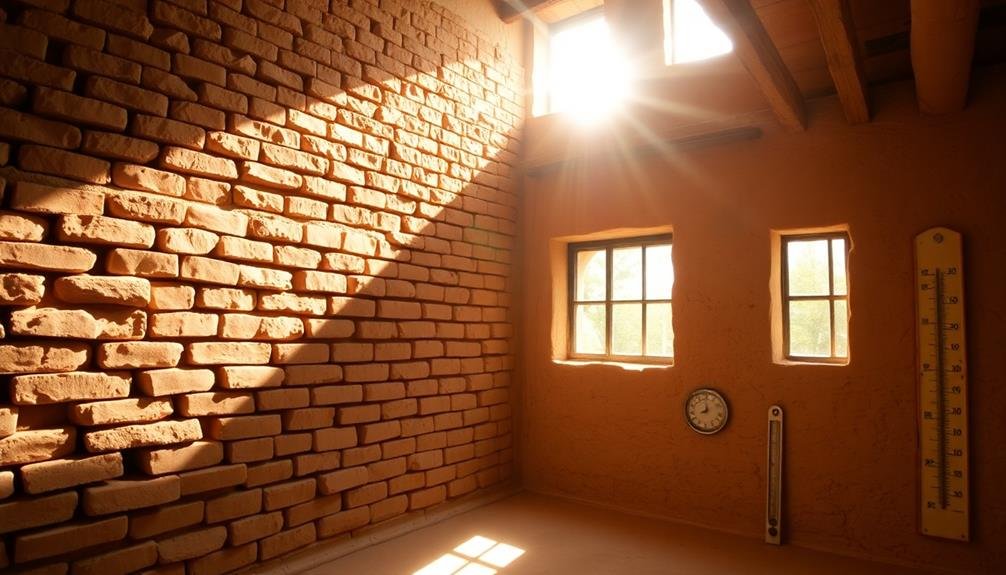
Sun-baked and time-tested, adobe clay stands as a champion of natural temperature regulation. You'll find this versatile material in traditional architecture across arid regions, where it's prized for its thermal mass properties. Adobe clay absorbs heat during the day and releases it slowly at night, creating a natural cooling effect in hot climates.
To use adobe clay in your home, you can incorporate it into walls, floors, or even as a plaster finish. Its high thermal inertia helps maintain a stable indoor temperature, reducing the need for artificial heating and cooling. You'll appreciate how adobe clay walls can keep your home cool in summer and warm in winter, potentially lowering your energy bills.
When building with adobe, you'll mix clay-rich soil with water and organic materials like straw or sand. The resulting bricks are then sun-dried, making it an eco-friendly construction method.
Adobe's breathability also helps regulate indoor humidity, creating a more comfortable living environment. While it requires proper maintenance and weatherproofing, adobe clay's durability and energy efficiency make it an excellent choice for sustainable home design.
Bentonite Clay
While adobe clay excels in arid climates, bentonite clay offers unique benefits for temperature control in various environments. You'll find this versatile clay particularly useful for its ability to absorb and release moisture, which helps regulate indoor humidity levels. This property makes bentonite an excellent choice for both hot and cold climates.
When used in construction, bentonite clay can form a highly effective vapor barrier. You can apply it as a thin layer beneath floors or within walls to prevent moisture penetration and improve insulation. Its swelling properties also make it ideal for sealing gaps and cracks, further enhancing your home's energy efficiency.
You'll appreciate bentonite's natural cooling effect in summer, as it absorbs excess heat and moisture from the air. In winter, it helps retain warmth by reducing heat loss through walls and floors.
Consider incorporating bentonite clay into your home's design through plaster finishes, flooring underlayments, or even as a component in eco-friendly paint. Its non-toxic nature and resistance to mold and bacteria make it a safe, sustainable option for improving your home's temperature control and overall comfort.
Kaolin Clay
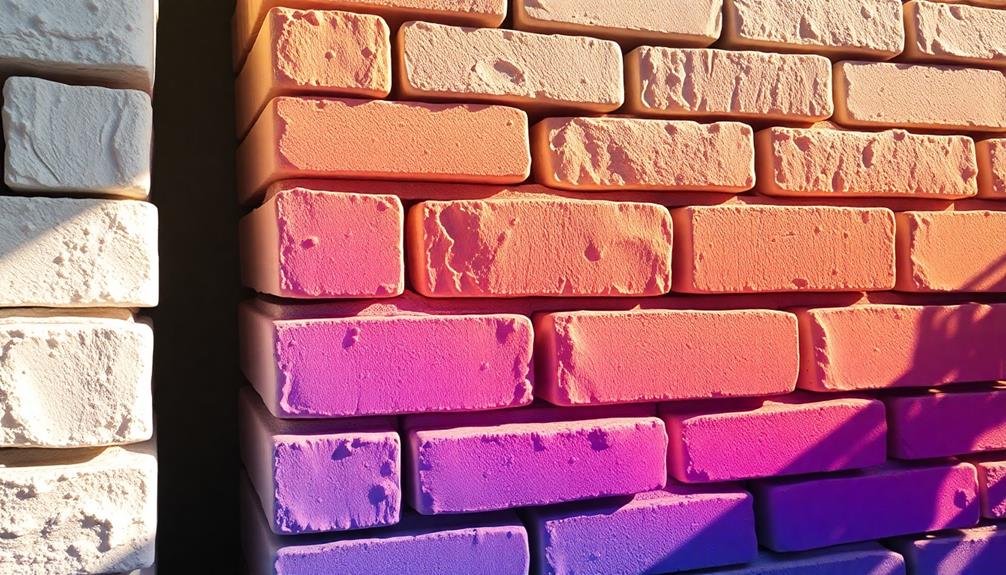
Kaolin clay, also known as China clay, offers unique properties for home temperature control. This fine-grained, white clay is composed primarily of the mineral kaolinite and has excellent insulating capabilities. You'll find that kaolin clay's low thermal conductivity helps maintain consistent indoor temperatures by reducing heat transfer through walls and roofs.
When you incorporate kaolin clay into your home's construction or renovation, you're leveraging its ability to absorb and release moisture. This characteristic helps regulate humidity levels, creating a more comfortable living environment.
Kaolin clay's porous structure also contributes to its sound-dampening properties, which can enhance your home's overall comfort.
You can use kaolin clay in various applications, such as mixing it into plasters, paints, or coatings. It's particularly effective when added to earth-based building materials like adobe or cob.
By using kaolin clay, you're not only improving your home's temperature control but also benefiting from its non-toxic and environmentally friendly nature.
Remember that while kaolin clay is effective, it's often used in combination with other materials to achieve ideal temperature control in your home.
Terracotta
Terracotta's natural cooling properties make it an excellent choice for temperature regulation in your home.
You'll find this sustainable building material used in various architectural applications, from roof tiles to wall cladding.
Its versatility allows you to incorporate terracotta elements seamlessly into both traditional and modern home designs, enhancing both aesthetics and thermal comfort.
Natural Cooling Properties
Among clay materials, terracotta stands out for its remarkable natural cooling properties. You'll find that its porous structure allows for excellent air circulation, effectively reducing indoor temperatures. When used in construction, terracotta tiles and bricks absorb heat during the day and release it at night, creating a natural cooling cycle.
You can leverage terracotta's cooling abilities in various ways. Consider installing terracotta roof tiles, which shield your home from direct sunlight and dissipate heat efficiently. Additionally, terracotta wall cladding can act as a thermal barrier, keeping your interior spaces cooler.
Here's a comparison of terracotta's cooling properties with other materials:
| Material | Heat Absorption | Heat Dissipation | Cooling Effect |
|---|---|---|---|
| Terracotta | High | Gradual | Excellent |
| Concrete | Medium | Slow | Moderate |
| Metal | Very High | Rapid | Poor |
| Wood | Low | Moderate | Good |
You'll notice that terracotta outperforms many common building materials regarding cooling efficiency. Its natural properties make it an ideal choice for sustainable temperature control in your home, reducing your reliance on artificial cooling systems and potentially lowering your energy costs.
Versatile Architectural Applications
In addition to its cooling properties, terracotta boasts a wide range of architectural applications. You'll find this versatile material used in various forms throughout buildings, from roofing tiles to wall cladding.
Terracotta's durability and weather resistance make it an excellent choice for exterior elements, protecting your home from the elements while adding a touch of warmth and character.
You can incorporate terracotta into your home's design through decorative panels, screens, or even custom-molded shapes. Its natural color variations and ability to be glazed offer endless aesthetic possibilities.
For flooring, terracotta tiles provide a cool, earthy feel underfoot and contribute to temperature regulation.
Don't overlook terracotta's potential in interior design. You can use it for accent walls, fireplace surrounds, or even as a unique material for kitchen backsplashes.
Its thermal mass properties make it an excellent choice for passive solar design, absorbing heat during the day and releasing it at night.
When planning your home's temperature control strategy, consider terracotta's versatility. It's not just a material for cooling; it's an all-encompassing solution that combines functionality with timeless beauty.
Sustainable Building Material
When considering sustainable building materials, terracotta stands out as an environmentally friendly choice. You'll find that this clay-based material isn't only durable but also requires minimal processing, reducing its carbon footprint.
Terracotta's production consumes less energy compared to concrete or steel, making it a greener option for your home.
You can appreciate terracotta's recyclability, as it can be crushed and reused in new construction or landscaping projects. Its long lifespan means you won't need frequent replacements, further reducing waste.
Terracotta's natural composition guarantees it's free from harmful chemicals, contributing to better indoor air quality.
You'll benefit from terracotta's ability to regulate indoor temperature naturally. It absorbs excess moisture during humid conditions and releases it when the air is dry, helping maintain a comfortable living environment.
This natural climate control can lead to reduced energy consumption for heating and cooling.
Earthen Plaster
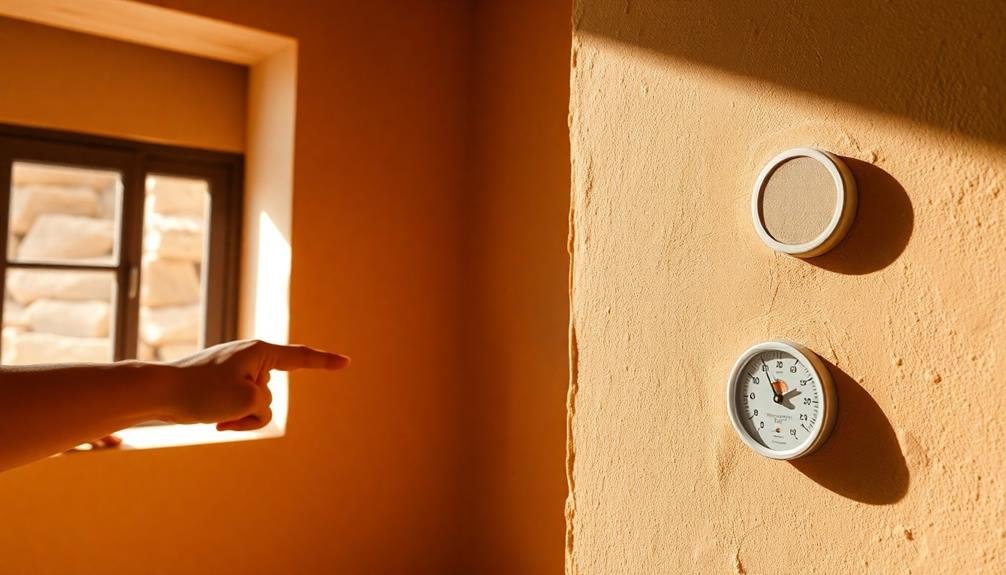
You'll find earthen plaster to be an excellent natural insulator for your home.
Its composition of clay, sand, and fiber creates a breathable layer that regulates indoor temperatures effectively.
You can easily apply earthen plaster yourself using simple techniques, making it a cost-effective option for improving your home's thermal performance.
Natural Insulation Properties
Clay's natural insulation properties make it an excellent choice for earthen plaster applications in home temperature control. When you use clay-based plaster, you're tapping into a material that's been regulating temperatures for millennia.
Clay has a high thermal mass, meaning it absorbs and stores heat energy efficiently. This property allows it to slowly release warmth during cooler periods and absorb excess heat when temperatures rise.
You'll find that clay plaster helps maintain a consistent indoor temperature by reducing thermal fluctuations. It's particularly effective in moderating humidity levels, absorbing excess moisture when the air is damp and releasing it when conditions are dry. This natural humidity regulation contributes to a more comfortable living environment and can help prevent issues like mold growth.
Clay's microporous structure also aids in its insulating capabilities. The tiny air pockets within the clay act as barriers to heat transfer, slowing down the movement of thermal energy through walls.
This feature enhances the overall energy efficiency of your home, potentially reducing heating and cooling costs. By choosing clay-based earthen plaster, you're utilizing a sustainable, non-toxic material that works with nature to create a more comfortable and energy-efficient living space.
Easy Application Techniques
In recent years, applying earthen plaster has become more accessible to DIY enthusiasts. You'll find that this natural material isn't only eco-friendly but also easy to work with.
To get started, you'll need to mix clay, sand, and water to create a smooth, workable consistency. You can apply the plaster using basic tools like trowels, sponges, and your hands.
Before application, make certain your walls are clean and free of debris. Apply the plaster in thin layers, allowing each to dry before adding the next. This technique helps prevent cracking and guarantees a durable finish. You can create various textures by experimenting with different application methods and tools.
Here are four key steps for successful earthen plaster application:
- Prepare your surface properly
- Mix your plaster to the right consistency
- Apply in thin, even layers
- Allow sufficient drying time between coats
Don't forget to protect floors and fixtures before you begin. You'll also want to wear protective gear, as clay can be messy.
With practice, you'll develop a feel for the material and create beautiful, naturally insulating walls that contribute to efficient home temperature control.
Rammed Earth
Although less common than traditional clay bricks, rammed earth stands out as an exceptional material for temperature control in homes. This ancient building technique involves compacting a mixture of soil, clay, sand, and sometimes stabilizers like cement into formwork to create sturdy walls.
You'll find that rammed earth's thermal mass properties are remarkable. It absorbs heat during the day and releases it slowly at night, helping maintain a comfortable indoor temperature. The thick walls, typically 12-24 inches, provide excellent insulation against outdoor temperature fluctuations.
When you're considering rammed earth for your home, keep in mind that it's best suited for dry climates. In areas with high humidity or frequent rainfall, you'll need to take extra precautions to protect the walls from moisture damage. You can add stabilizers or use waterproof coatings to enhance durability.
One of the biggest advantages of rammed earth is its sustainability. It's made from local materials, requires minimal processing, and has a low carbon footprint.
You'll also appreciate its fire resistance and sound insulation properties. While it may require specialized construction techniques, the long-term benefits for temperature control make it a worthwhile consideration for your home.
Cob Construction
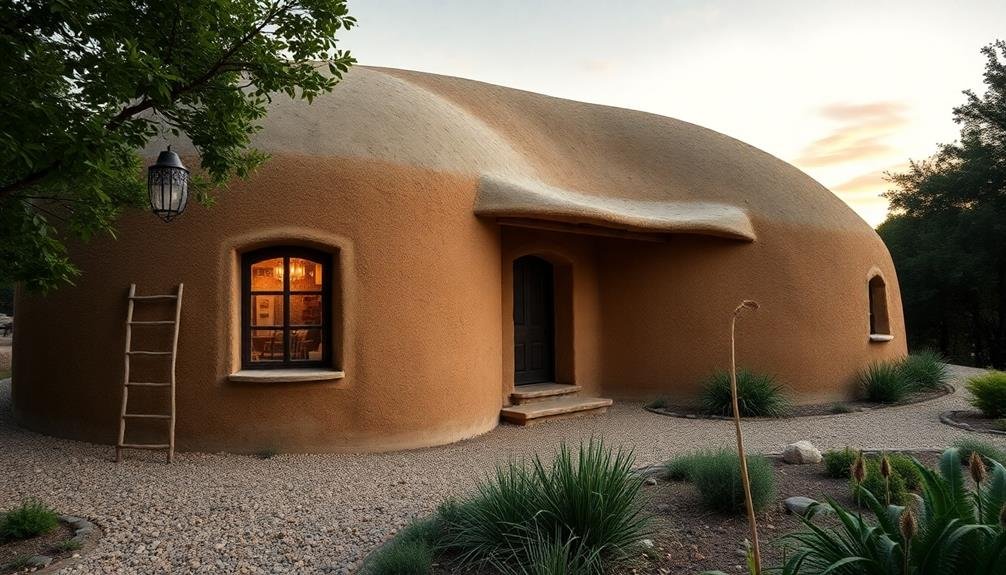
Moving from rammed earth, we encounter another ancient building technique that harnesses clay's thermal properties: cob construction. Cob is a mixture of clay, sand, straw, and water that's hand-sculpted into walls.
You'll find this method offers excellent thermal mass, helping regulate indoor temperatures naturally.
When you're assessing cob for your home, remember its key benefits:
- Superior insulation
- Breathable walls that manage humidity
- Fire-resistant properties
- Ability to form curved, organic shapes
Cob walls absorb heat during the day and release it at night, creating a stable indoor climate. You'll appreciate how this reduces your reliance on artificial heating and cooling systems.
The thick walls, typically 1-2 feet wide, provide substantial soundproofing too.
You can easily incorporate recycled materials into cob construction, making it an eco-friendly choice. While it's labor-intensive, you'll find the process rewarding and cost-effective.
Cob homes can last for centuries with proper maintenance, offering long-term sustainability. However, you'll need to take into account local building codes and moisture protection in wet climates before initiating a cob project.
Frequently Asked Questions
How Do Clay Materials Compare to Modern Insulation in Terms of Cost?
You'll find clay materials are generally cheaper than modern insulation options. They're often locally sourced, reducing transportation costs. However, modern insulation may be more cost-effective long-term due to its superior thermal performance and durability.
Can Clay-Based Temperature Control Systems Be Integrated With Smart Home Technology?
You can integrate clay-based temperature control with smart home tech. You'll need sensors and automated systems to monitor and adjust conditions. It's possible to create a hybrid setup that combines traditional clay materials with modern smart technology.
Are There Any Health Benefits Associated With Using Clay for Temperature Regulation?
You'll find clay offers several health benefits for temperature regulation. It's naturally antimicrobial, reduces humidity, and improves air quality. Clay can also help filter toxins, reduce allergens, and create a more comfortable living environment.
How Do Different Climates Affect the Effectiveness of Clay Temperature Control Materials?
You'll find clay's effectiveness varies with climate. In humid areas, it absorbs moisture, cooling better. In dry regions, it retains heat longer. It's most efficient in places with significant day-night temperature swings, adapting to your needs.
What Maintenance Is Required for Clay-Based Temperature Control Systems in Homes?
You'll need to regularly inspect your clay-based temperature control system for cracks or damage. Reapply clay coatings as needed, guarantee proper ventilation, and clean air vents. Don't forget to check moisture levels to prevent mold growth.
In Summary
You've now explored seven exceptional clay materials for regulating your home's temperature. Whether you choose adobe, bentonite, kaolin, terracotta, earthen plaster, rammed earth, or cob construction, you'll benefit from improved energy efficiency and natural climate control. Don't hesitate to experiment with these eco-friendly options. They'll not only keep you comfortable but also reduce your carbon footprint. Embrace the power of clay and transform your living space into a sustainable, temperature-regulated haven.

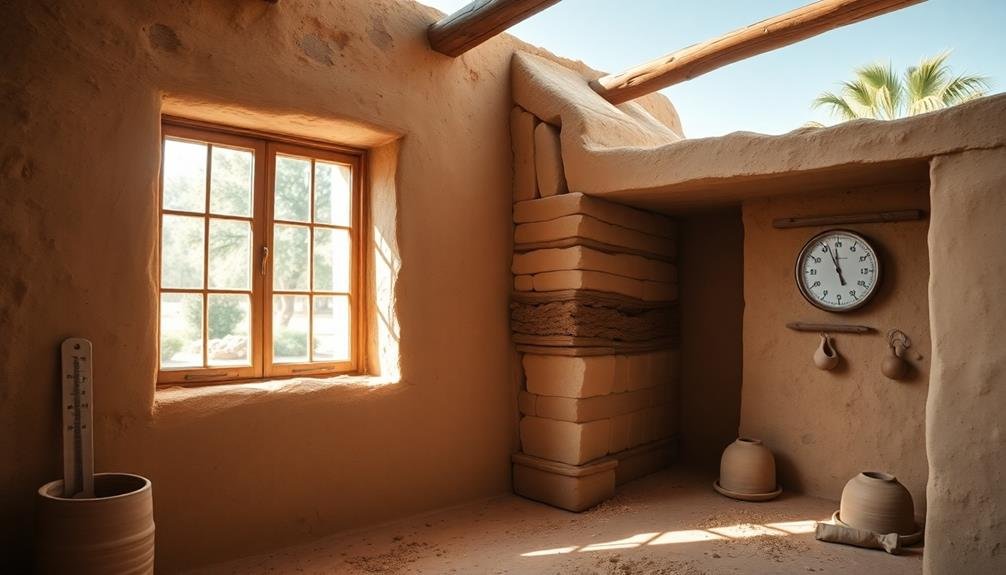
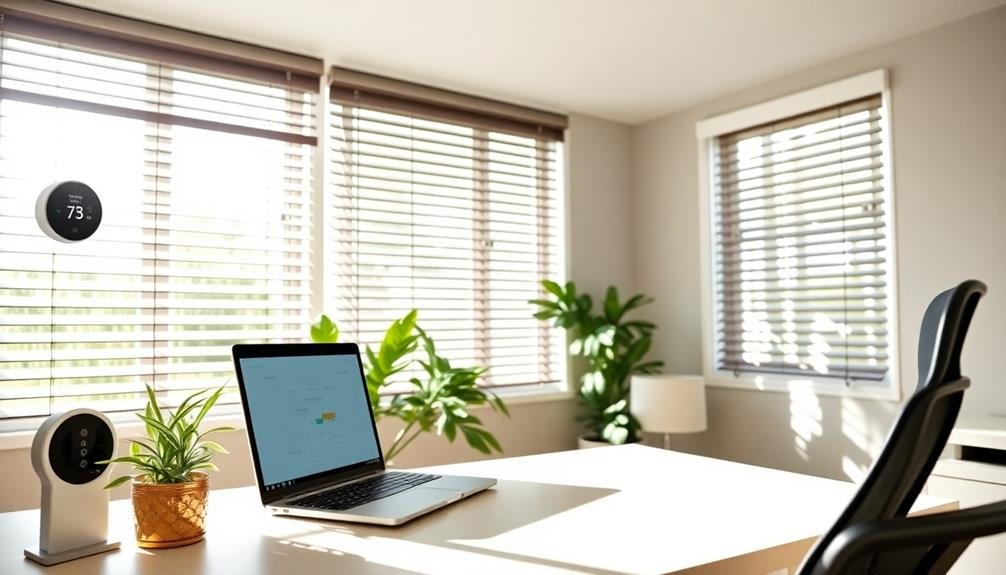


Leave a Reply